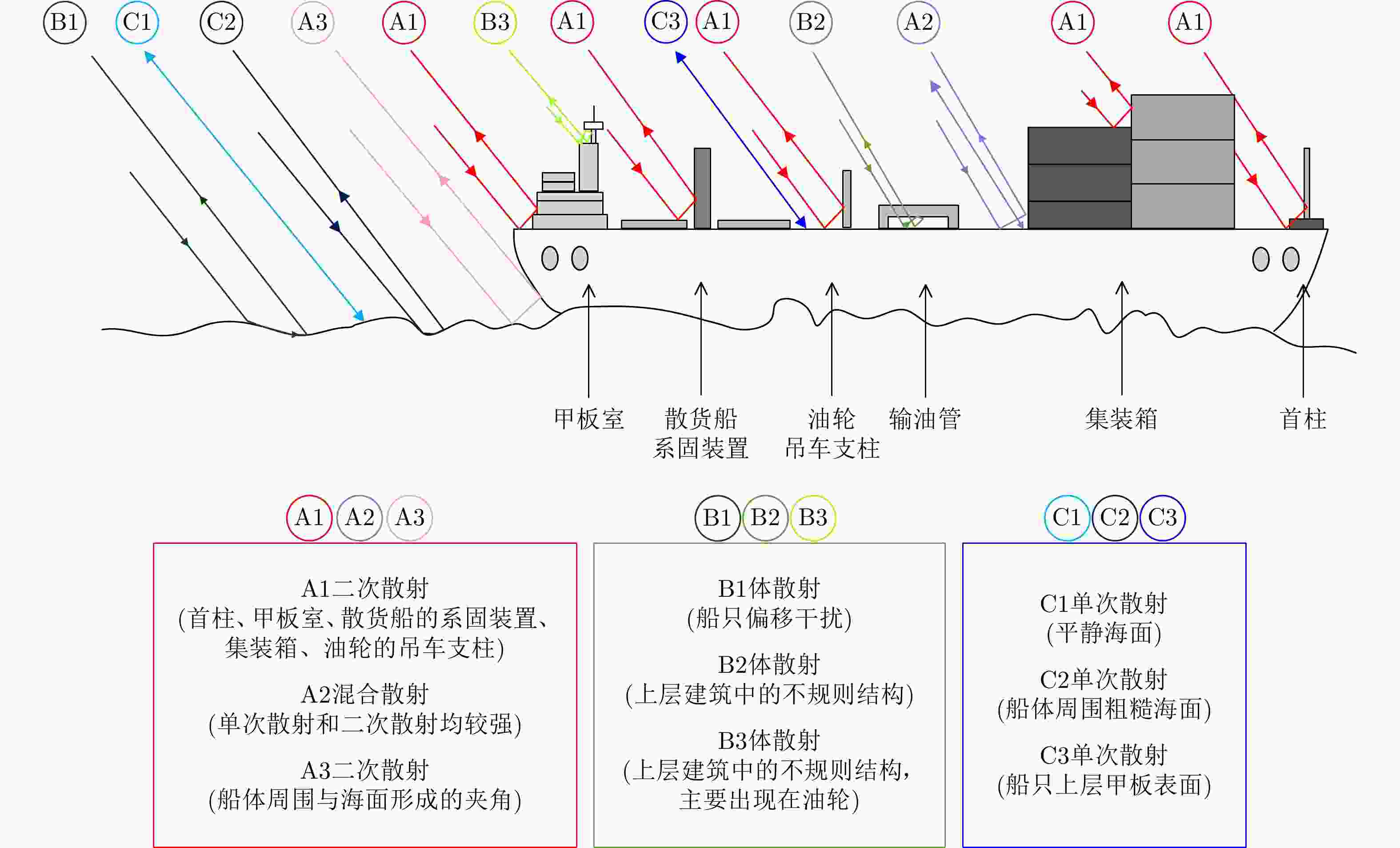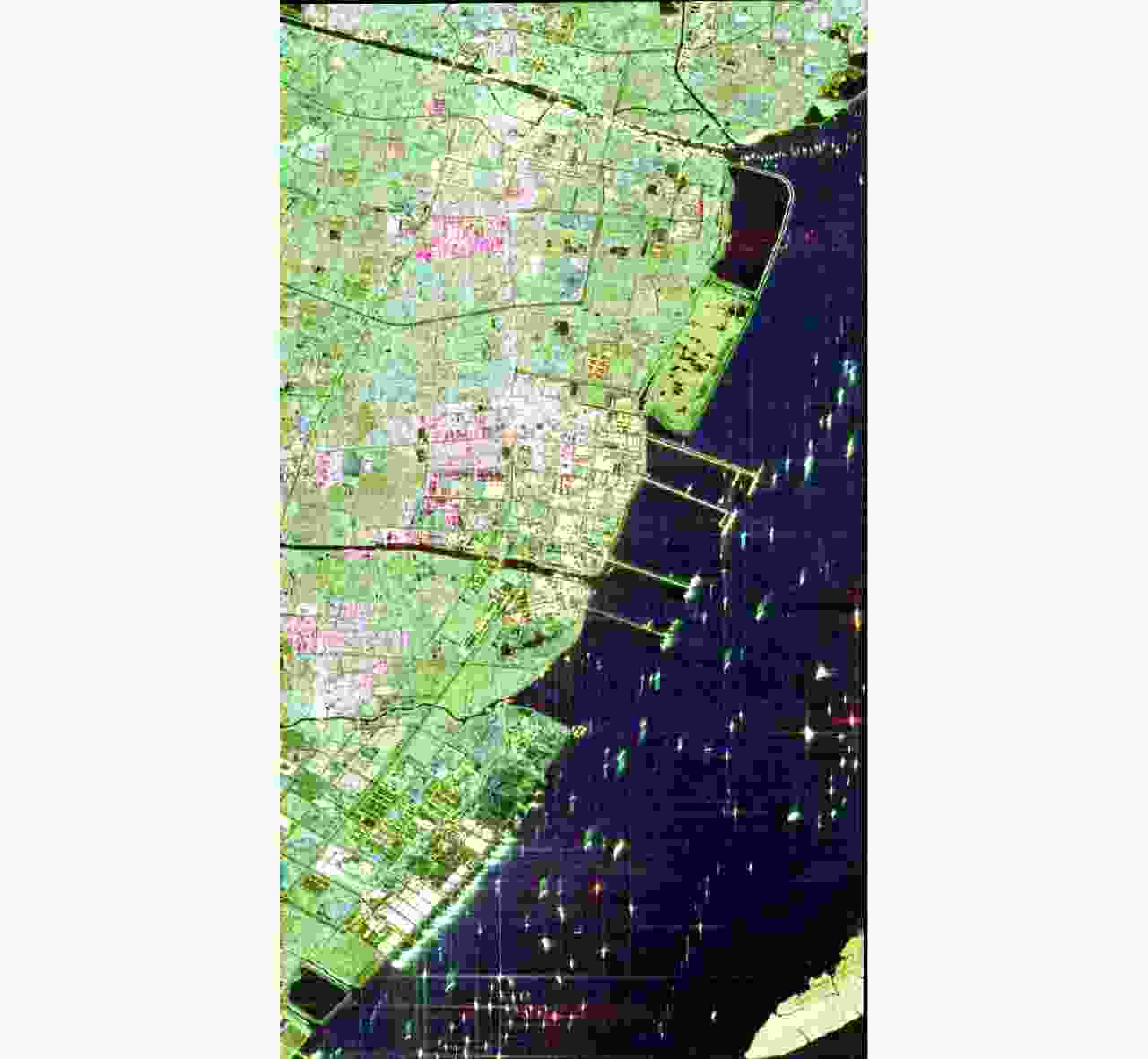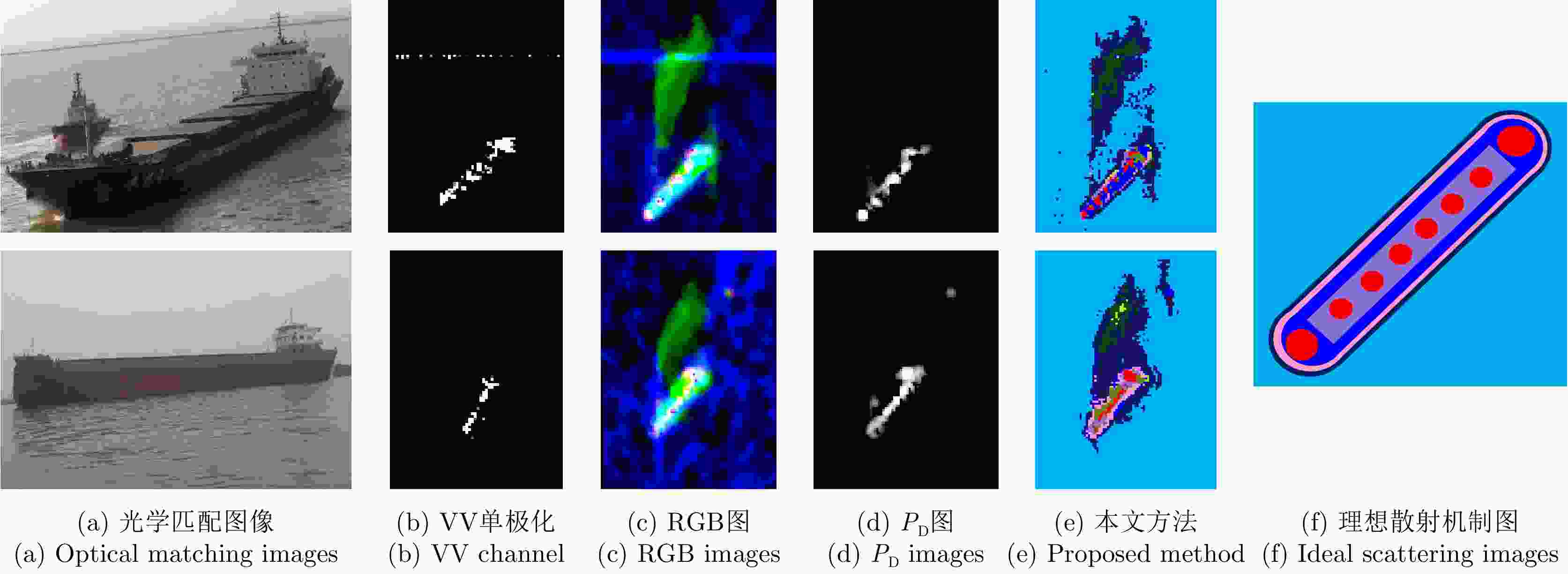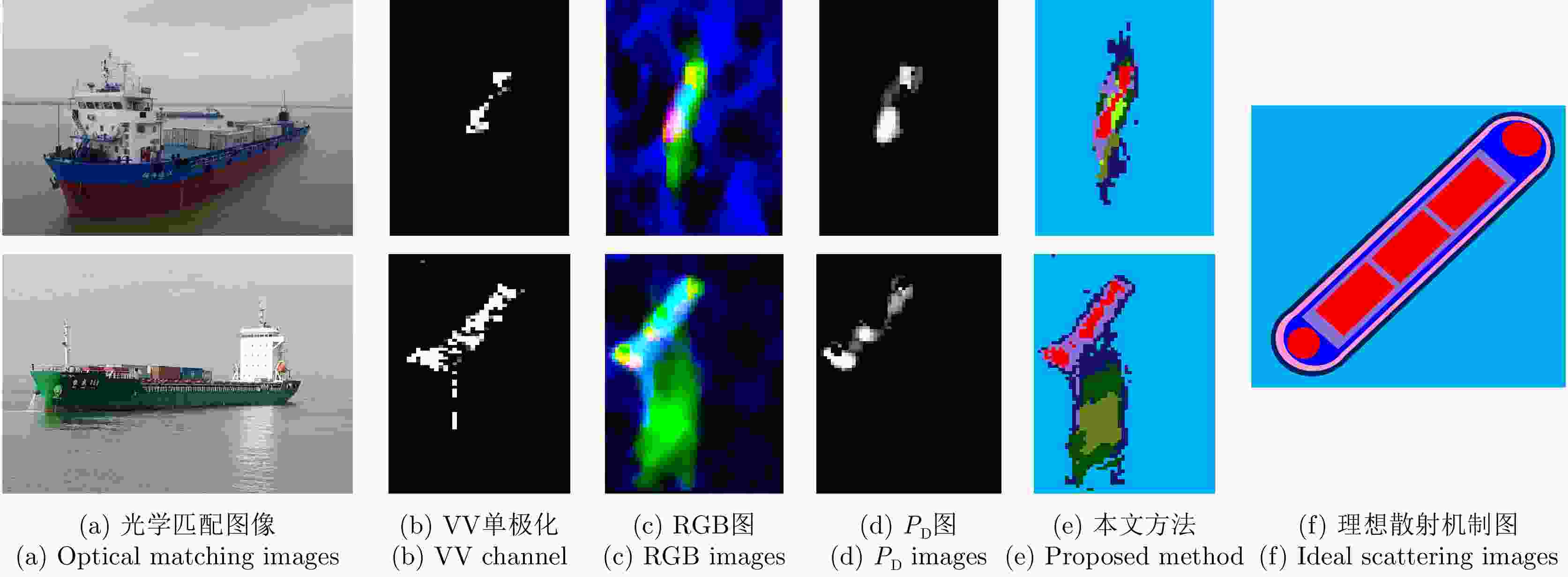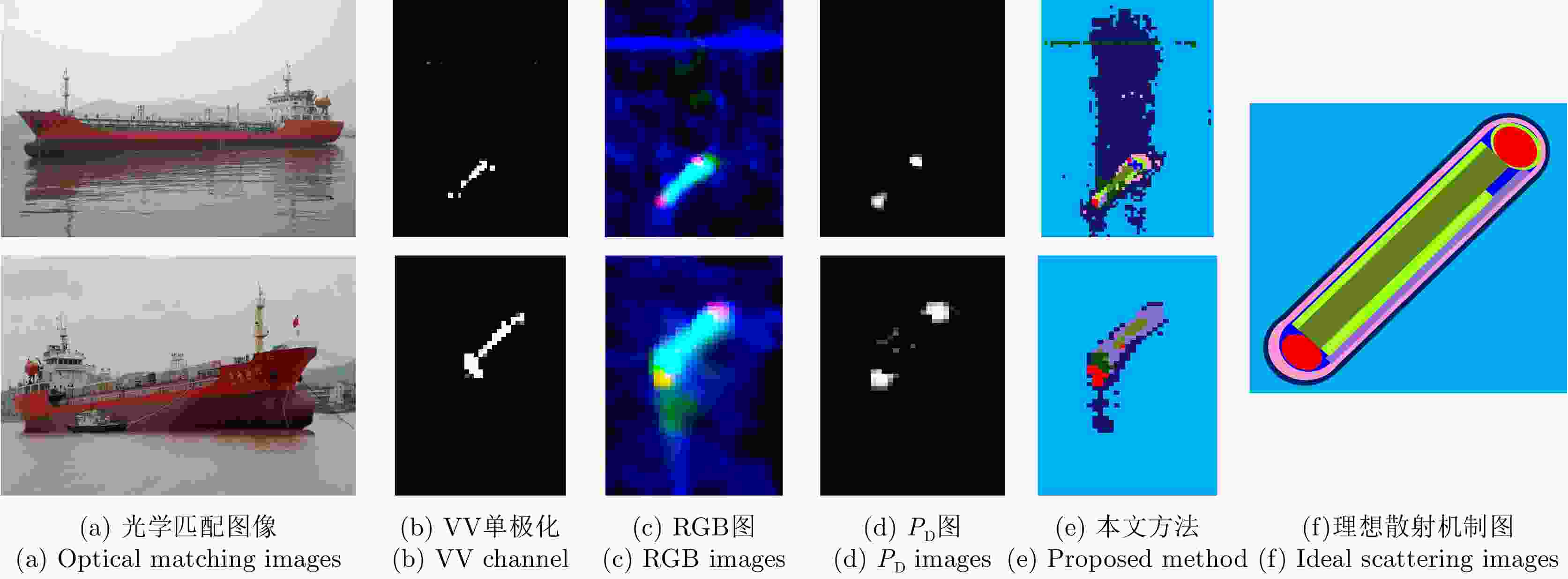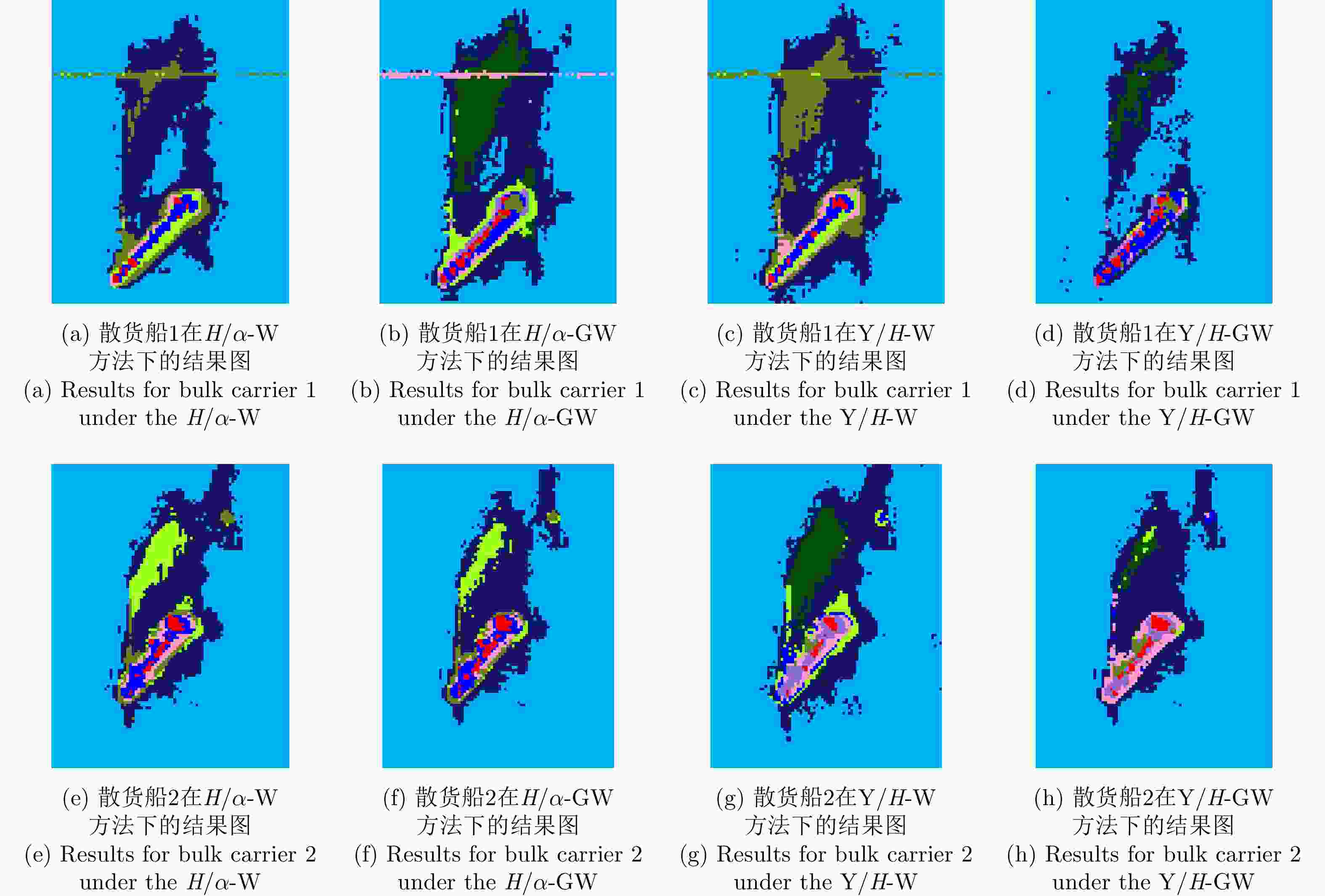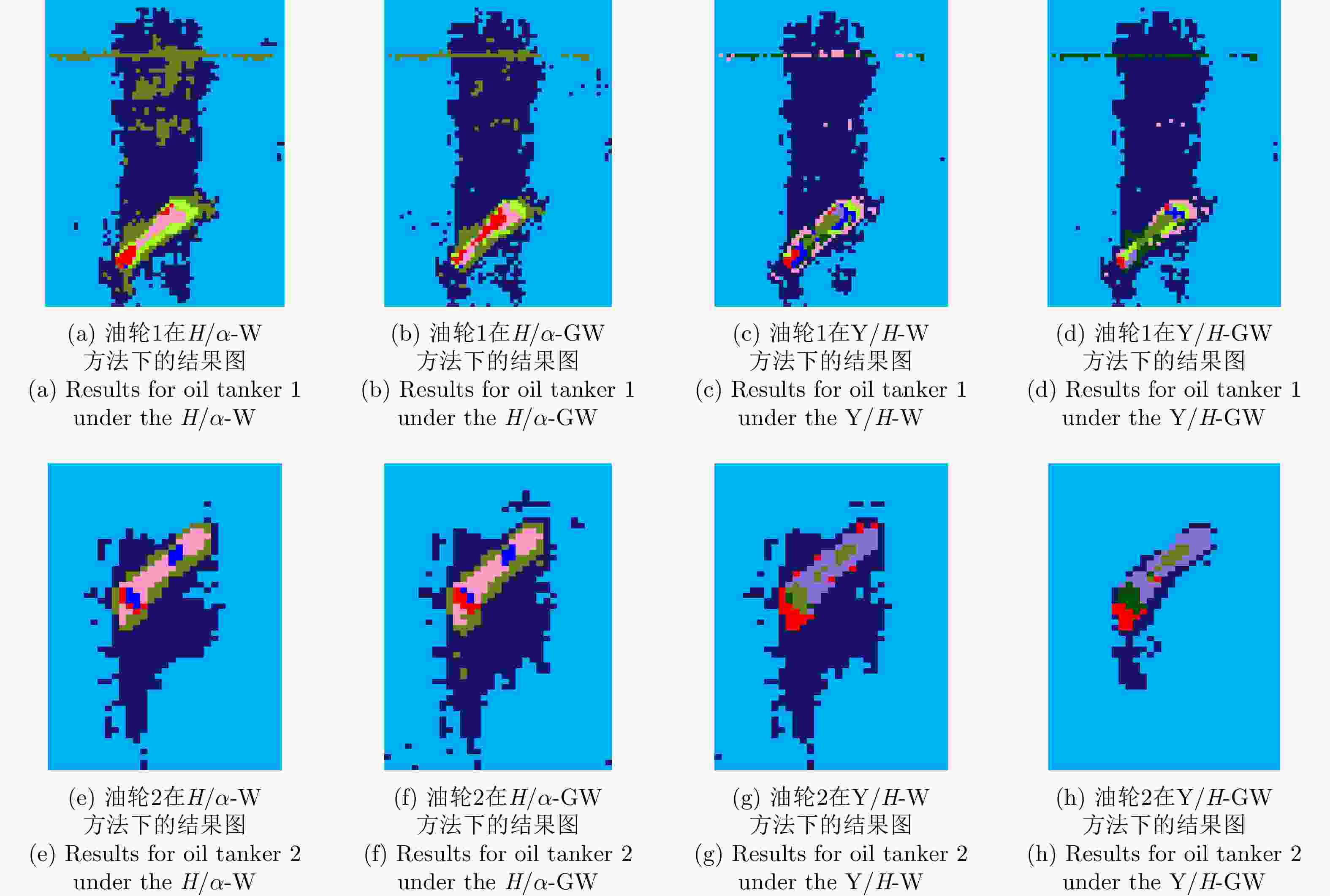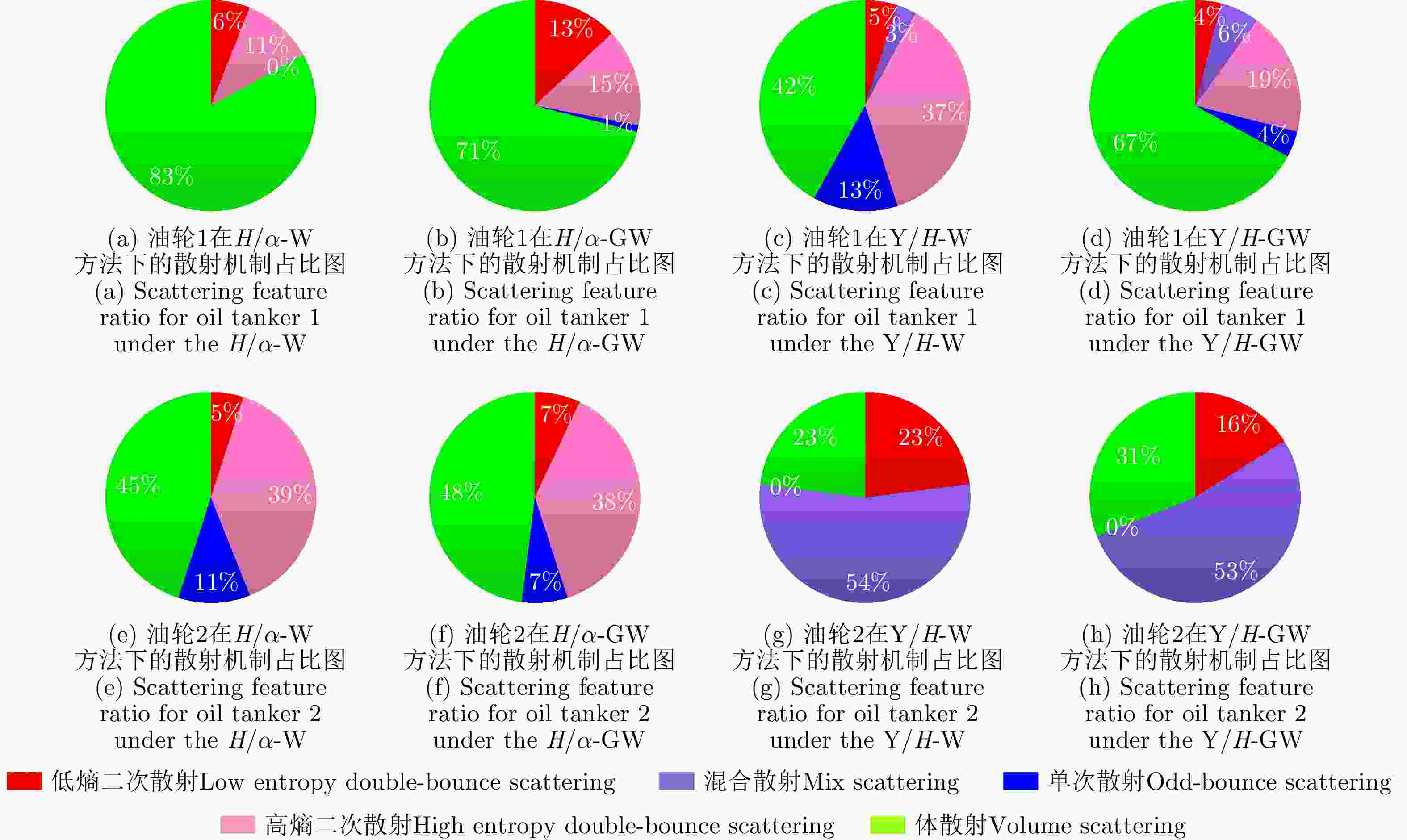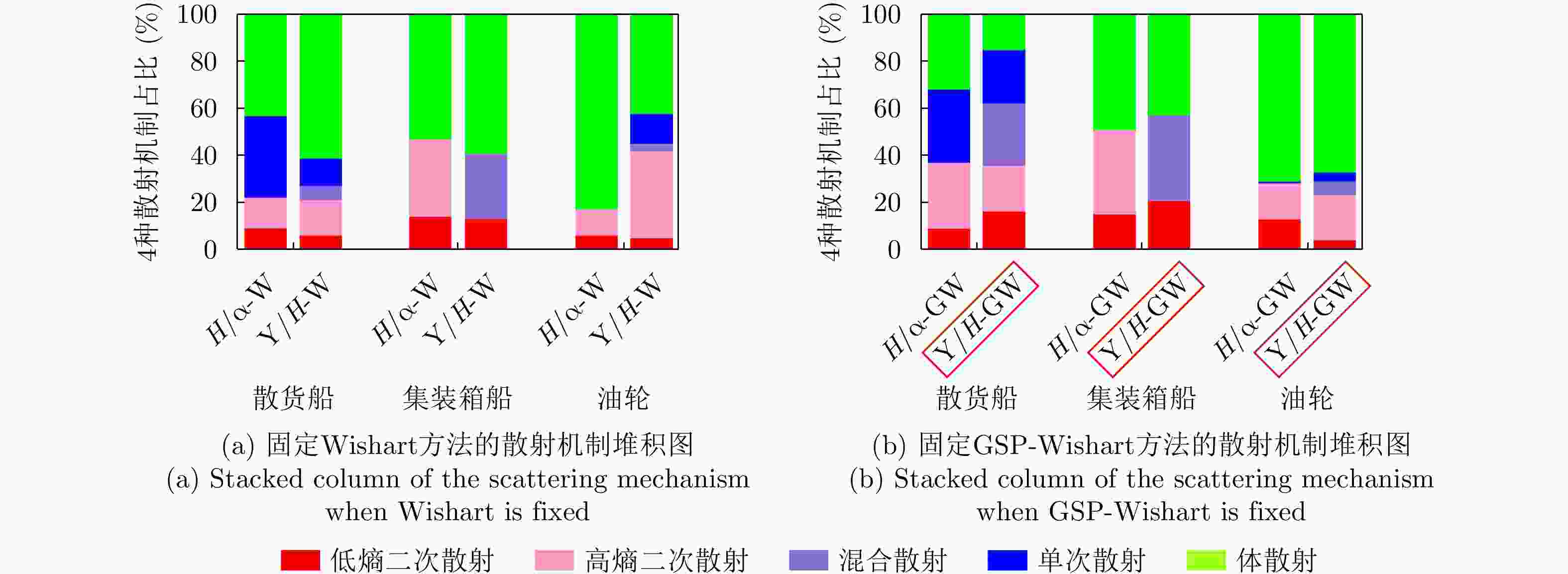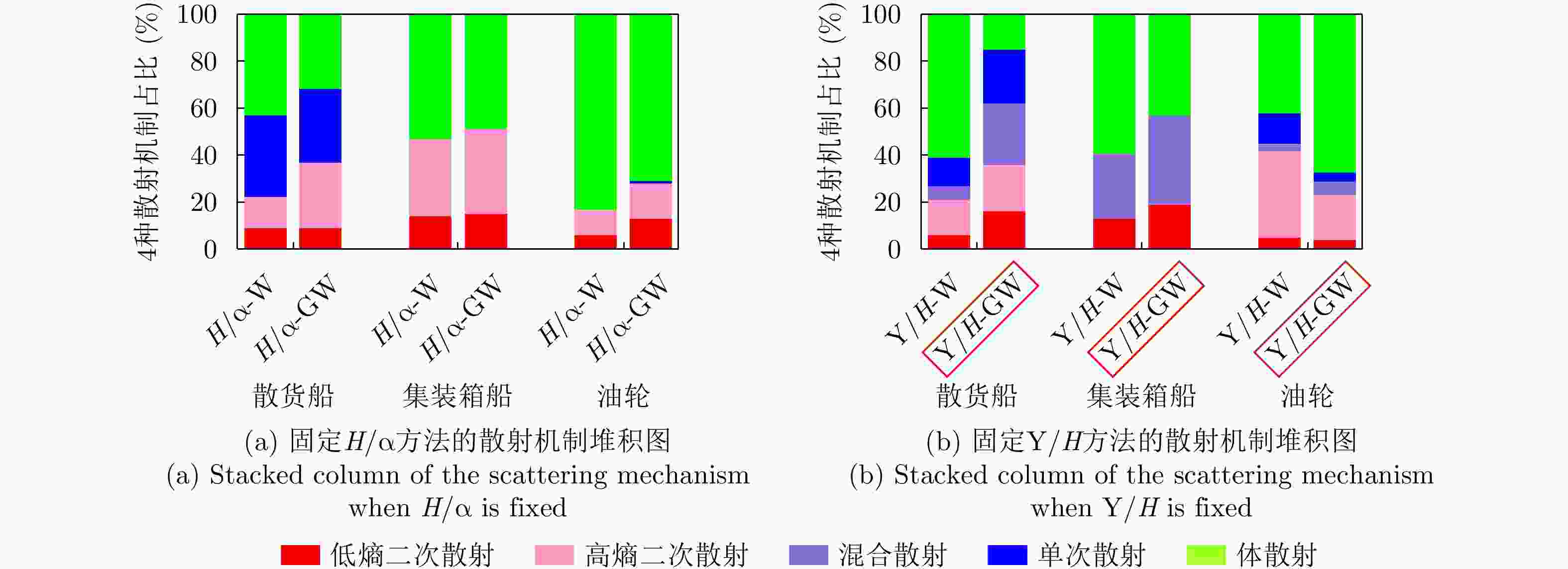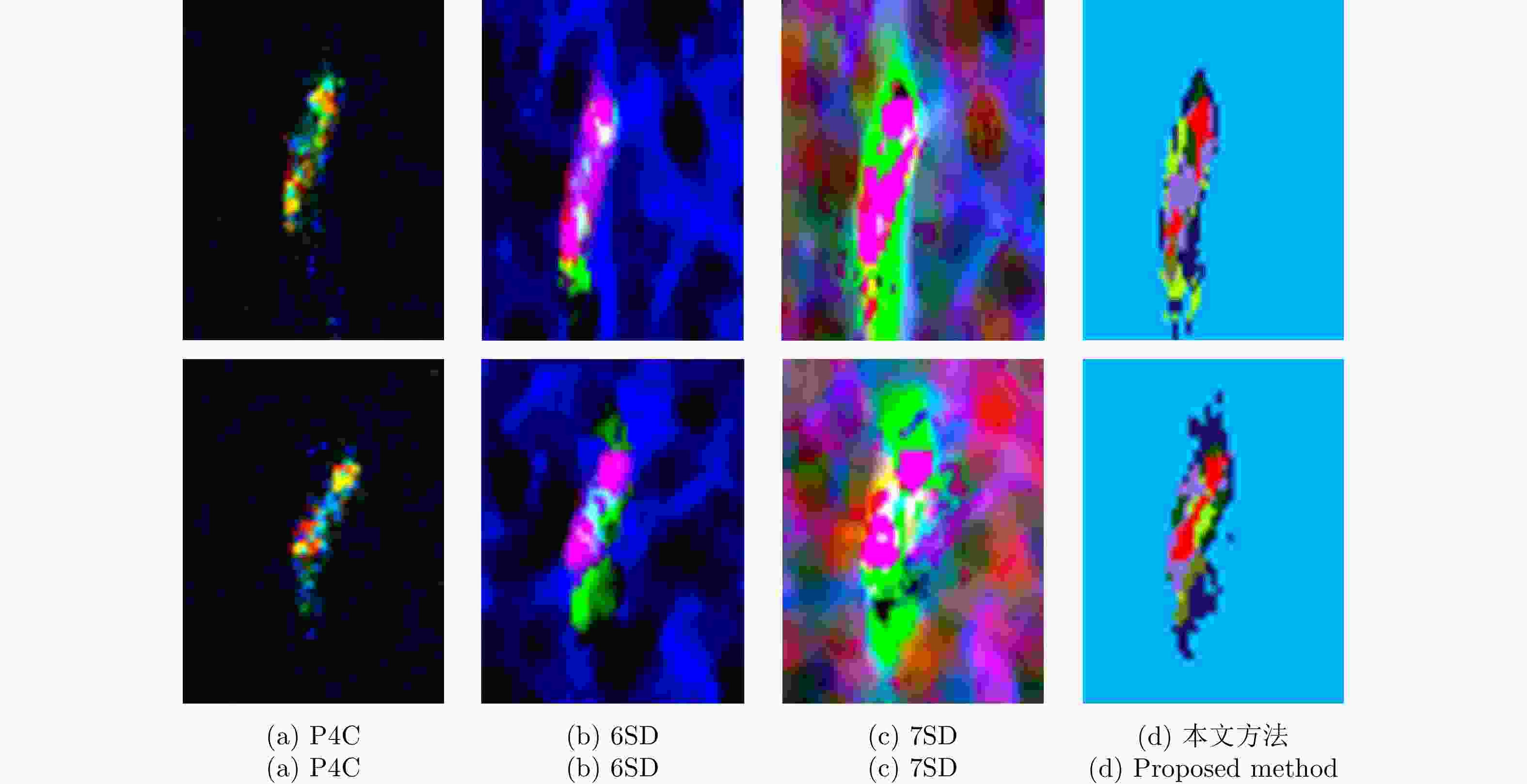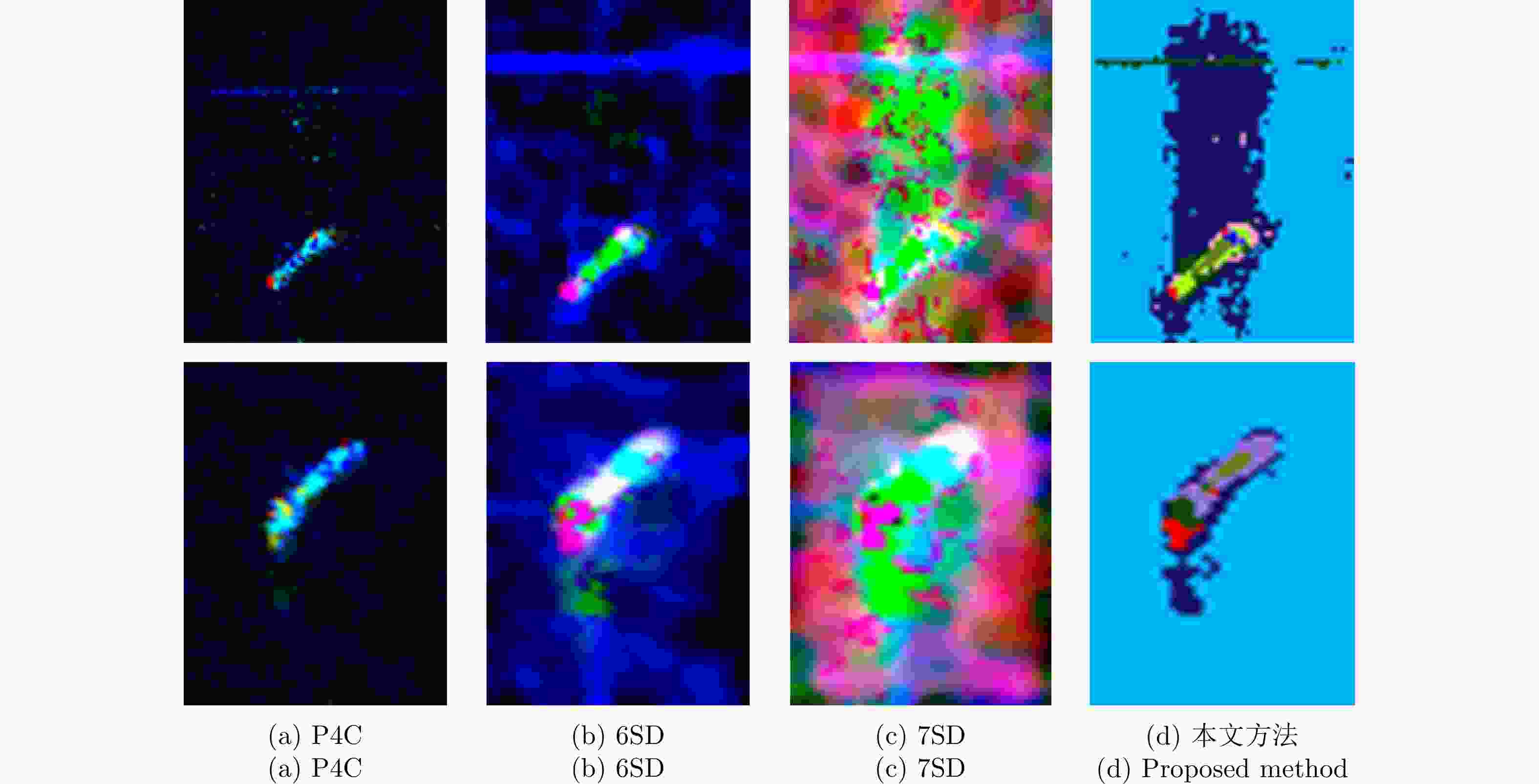Refined Ship Feature Characterization Method of Full-polarimetric Synthetic Aperture Radar for Visual Interpretation
-
摘要: 随着卫星技术的发展,极化合成孔径雷达(PolSAR)数据的分辨率和数据质量得到大幅提升,为人造目标的精细化目视解译提供了良好的数据条件。目前主要采用多分量分解的方法,但是易造成像素错分问题,为此,该文结合Yamaguchi极化分解和极化熵提出了一种非固定阈值划分的方法用于实现全极化SAR图像船只结构精细化特征表征。Yamaguchi极化分解能够识别基本散射机制,其修正后的体散射模型更符合实测数据,可有效对人造目标进行表征。极化熵H在弱去极化状态下可以看成某一指定等效点的目标散射机制,能够有效突出船只主散射特征。因此,该文通过将Yamaguchi极化分解算法的非固定三分量与极化熵的低中高熵内嵌,将其分为非固定阈值的九分类成分,从而降低硬阈值处理在阈值边界处受噪声影响产生的类别随机性。并且将二次散射和单次散射均显著的区域称为混合散射(MSM),以更好匹配实验中船只典型结构的散射类型。在此基础上,利用广义相似性参数进一步缩短类内距离,采用改进后的GSP-Wishart分类器进行迭代聚类,旨在通过提高二次散射和混合散射机制以提高不同类型船只可区分度。最后,该文采用中国上海某港口的高分三号全极化SAR数据进行实验,为了验证每艘船只特征表征正确性,通过船舶自动识别系统(AIS)收集并筛选了该港口船只信息及光学数据,并与极化SAR数据中每艘船只进行匹配。实验结果表明该方法可有效区分散货船、集装箱船和油轮3种类型船只。Abstract: With advances in satellite technology, Polarimetric Synthetic Aperture Radar (PolSAR) now have higher resolution and better data quality, providing excellent data conditions for the refined visual interpretation of artificial targets. The primary method currently used is a multicomponent decomposition, but this method can result in pixel misdivision problems. Thus, we propose a non-fixed threshold division method for achieving advanced feature ship structure characterization in full-polarimetric SAR images. Yamaguchi decomposition can effectively identify the primary scattering mechanism and characterize artificial targets. Its modified volume scattering model is more consistent with actual data. The polarization entropy can serve as the target scattering mechanism at a specified equivalent point in the weakly depolarized state, which can effectively highlight the ship structure. This paper combines the three components of the Yamaguchi decomposition algorithm with the entropy, and divides it into a nine-classification plane with a non-fixed threshold. This method reduces category randomness generated by noise at the threshold boundary for complicated threshold treatments. Furthermore, the Mixed Scattering Mechanism (MSM) which is the region where both secondary scattering and single scattering are significant, was proposed to better match the scattering types of typical structures of vessels in the experiment. The Generalized Similarity Parameter (GSP) was used to further shorten the intra-class distance and perform iterative clustering using a modified GSP-Wishart classifier. This method improves the vessel distinguishability by enhancing the secondary and mixed scattering mechanisms. Finally, this paper uses full-polarimetric SAR data from a port in Shanghai, China, for the experiment. We collected and filtered ship information and optical data from this port through the Automatic Identification System (AIS) and matched them with the ships in full-polarimetric SAR images to verify the correct characterization of each vessel’s features. The experimental results show that the proposed method can effectively distinguish three types of vessels: bulk carriers, container ships and tankers.
-
表 1 3种类型船只的Yamaguchi分解图及对应理想状态下散射机制图
Table 1. Yamaguchi decomposition images and the corresponding ideal images of three types of ships
类型 RGB图 CIE图 PD图 理想状态下船只散射机制图 散货船 



集装箱船 



油轮 



表 2 不同场景下对应的体散射矩阵
Table 2. Volume scattering matrix corresponding to different conditions
R ${ {\boldsymbol{T} }_{{\rm{V}}} }$ ${R}{ < - 2 \;{\rm{dB} } }$ $\dfrac{ {1} }{ { {30} } }\left[ {\begin{array}{*{20}{c} } {15}&{5}&{0} \\ {5}&{7}&{0} \\ {0}&{0}&{8} \end{array} } \right]$ ${ - 2 \;{\rm{dB} } < }{R}{ < 2 \;{\rm{dB} } }$ $\dfrac{ {1} }{ {4} }\left[ {\begin{array}{*{20}{l} } {2}& {0}& {0} \\ {0}& {1}& {0} \\ {0}& {0}& {1} \end{array} } \right]$ ${R}{ > 2 \;{\rm{dB} } }$ $\dfrac{ {1} }{ { {30} } }\left[ {\begin{array}{*{20}{c} } { {15} }& { { - 5} }& {0} \\ { { - 5} }& {7}& {0} \\ {0}& {0}& {8} \end{array} } \right]$ 1 Yamaguchi/H-GSPWishart算法流程
1. Yamaguchi/H-GSPWishart algorithm
1. 初始化:设置参数设置聚类最大迭代次数maxiter; 2. begin: 3. for 对每一像素Ni 4. 计算特征值和特征向量,通过式(3)计算极化熵H; 5. 利用式(4)计算整体功率TP,式(2)计算同极化比R,选
择对应体散射矩阵TV;6. 分别计算体散射功率PV和螺旋散射功率PC; 7. if PV+PC<TP 8. 通过相干矩阵T和PS计算T0; 9. if Re(C0)<0 10. 通过极化熵H内嵌计算二次散射三分类; 11. else if Re(C0)$\ge$0 12. 通过极化熵H内嵌可得单次散射三分类; 13. end 14. else 15. 通过极化熵H内嵌可得体散射三分类; 16. end 17. while iter≤maxiter 18. for 对每一像素Ni 19. 计算初分类每一类别的平均相干矩阵T得到聚类
中心;20. 通过式(6)分别计算每一像素旋转后的相干矩阵
A及聚类中心矩阵B;21. 通过式(7)分别计算每一像素点与类中心的广义相
似性参数;22. 通过式(9)计算每一像素元到聚类中心的GSP-
Wishart距离,找到距离最小的所属类别;23. end 24. iter = iter+1 25. 更新聚类中心; 26. end 27. 输出结果 表 3 上海地区全极化数据参数
Table 3. GaoFen-3 satellite parameters of the FP-SAR over Shanghai, China
参数 指标 极化方式 全极化 成像模式 全极化条带1 (QPSI) 产品形式 单视复数产品(SLC) 升/降轨 升轨ASC 标准分辨率 8 m 长度×宽度 8074 m×7882 m 长度分辨率 4.762506 m 宽度分辨率 2.248443 m 视数 1×1 表 4 上海地区典型船只信息和光学图像
Table 4. Information and optical images of typical ships over Shanghai, China
MMSI 船只名称 船只类型 长度(m) 宽度(m) 光学图像 414330000 SHEN YU 69 散货船 191 32 
413240950 GAO LAN 309 散货船 155 23 
413653000 QIU JIN 集装箱船 135 21 
413697150 XIN BIN HE 集装箱船 156 21 
413335470 HANG HAI JIA 369 油轮 118 17 
413269010 NING SHEN HAI HUA 11 油轮 133 21 
表 5 4种方法下船只散射分量占比表
Table 5. The scattering feature ratio corresponding to these four methods
船只类型 $ H/\bar \alpha $-Wishart $ H/\bar \alpha $-GSPWishart Yamaguchi/H-Wishart Yamaguchi/H-GSPWishart Ld M Hd S V Ld M Hd S V Ld M Hd S V Ld M Hd S V 散货船 1 9 0 13 35 43 9 0 28 31 32 6 6 15 12 61 17 18 6 47 12 2 16 0 20 35 29 18 0 18 34 30 6 24 19 16 35 11 28 21 24 16 集装箱船 3 14 0 33 0 53 15 0 36 0 49 13 28 0 0 59 19 38 0 0 43 4 20 0 17 1 62 25 0 17 2 56 14 21 0 0 65 25 30 0 0 45 油轮 5 6 0 11 0 83 13 0 15 1 71 5 3 37 13 42 4 6 19 4 67 6 5 39 22 0 45 7 38 0 7 48 23 54 0 0 23 16 53 0 0 31 注:加粗的数值表示在4种方法中低熵二次散射和混合散射所占比最大的方法。 表 6 3种类型船只散射机理
Table 6. Refinement scattering mechanism of three types of ships
类型 理想散射机制图 本文精细化结果图 散射机理 散货船 

船只中段以中轴线上排布的离散红色
二次散射为主,呈明显点状排布,
上层甲板以单次散射和混合散射为主集装箱船 

船只中段呈现与船只宽度相当的密集
红色二次散射,上层甲板以单次散射和
二次散射叠加而成,呈现为紫色混合散射油轮 

船首船尾以红色二次散射为主,船只中段以绿色体散射为主 -
[1] 张杰, 张晰, 范陈清, 等. 极化SAR在海洋探测中的应用与探讨[J]. 雷达学报, 2016, 5(6): 596–606. doi: 10.12000/JR16124.ZHANG Jie, ZHANG Xi, FAN Chenqing, et al. Discussion on application of polarimetric synthetic aperture radar in marine surveillance[J]. Journal of Radars, 2016, 5(6): 596–606. doi: 10.12000/JR16124. [2] 代大海, 廖斌, 肖顺平, 等. 雷达极化信息获取与处理的研究进展[J]. 雷达学报, 2016, 5(2): 143–155. doi: 10.12000/JR15103.DAI Dahai, LIAO Bin, XIAO Shunping, et al. Advancements on radar polarization information acquisition and processing[J]. Journal of Radars, 2016, 5(2): 143–155. doi: 10.12000/JR15103. [3] 赵春雷, 王亚梁, 阳云龙, 等. 雷达极化信息获取及极化信号处理技术研究综述[J]. 雷达学报, 2016, 5(6): 620–638. doi: 10.12000/JR16092.ZHAO Chunlei, WANG Yaliang, YANG Yunlong, et al. Review of radar polarization information acquisition and polarimetric signal processing techniques[J]. Journal of Radars, 2016, 5(6): 620–638. doi: 10.12000/JR16092. [4] SATO A, YAMAGUCHI Y, SINGH G, et al. Four-component scattering power decomposition with extended volume scattering model[J]. IEEE Geoscience and Remote Sensing Letters, 2012, 9(2): 166–170. doi: 10.1109/LGRS.2011.2162935. [5] CHEN Siwei, WANG Xuesong, XIAO Shunping, et al. General polarimetric model-based decomposition for coherency matrix[J]. IEEE Transactions on Geoscience and Remote Sensing, 2014, 52(3): 1843–1855. doi: 10.1109/TGRS.2013.2255615. [6] XI Yuyang, LANG Haitao, TAO Yunhong, et al. Four-component model-based decomposition for ship targets using PolSAR data[J]. Remote Sensing, 2017, 9(6): 621. doi: 10.3390/rs9060621. [7] SINGH G and YAMAGUCHI Y. Model-based six-component scattering matrix power decomposition[J]. IEEE Transactions on Geoscience and Remote Sensing, 2018, 56(10): 5687–5704. doi: 10.1109/TGRS.2018.2824322. [8] SINGH G, MALIK R, MOHANTY S, et al. Seven-component scattering power decomposition of POLSAR coherency matrix[J]. IEEE Transactions on Geoscience and Remote Sensing, 2019, 57(11): 8371–8382. doi: 10.1109/TGRS.2019.2920762. [9] PAN Xueli, WU Zhenhua, YANG Lixia, et al. Ship detection method based on scattering contribution for PolSAR image[J]. IEEE Geoscience and Remote Sensing Letters, 2022, 19: 4503205. doi: 10.1109/LGRS.2021.3138796. [10] 全斯农, 范晖, 代大海, 等. 一种基于精细极化目标分解的舰船箔条云识别方法[J]. 雷达学报, 2021, 10(1): 61–73. doi: 10.12000/JR20123.QUAN Sinong, FAN Hui, DAI Dahai, et al. Recognition of ships and chaff clouds based on sophisticated polarimetric target decomposition[J]. Journal of Radars, 2021, 10(1): 61–73. doi: 10.12000/JR20123. [11] LIU Dongsheng and HAN Ling. Integration of fine model-based decomposition and guard filter for ship detection in PolSAR images[J]. Sensors, 2021, 21(13): 4295. doi: 10.3390/s21134295. [12] QUAN Sinong, ZHANG Tao, WANG Wei, et al. Exploring fine polarimetric decomposition technique for built-up area monitoring[J]. IEEE Transactions on Geoscience and Remote Sensing, 2023, 61: 5204719. doi: 10.1109/TGRS.2023.3257773. [13] CUI Xingchao, SU Yi, and CHEN Siwei. A saliency detector for polarimetric SAR ship detection using similarity test[J]. IEEE Journal of Selected Topics in Applied Earth Observations and Remote Sensing, 2019, 12(9): 3423–3433. doi: 10.1109/JSTARS.2019.2925833. [14] LIN Huiping, WANG Hongmiao, WANG Jing, et al. A novel ship detection method via generalized polarization relative entropy for PolSAR images[J]. IEEE Geoscience and Remote Sensing Letters, 2022, 19: 4001205. doi: 10.1109/LGRS.2020.3019196. [15] 殷君君, 彭嘉耀, 杨健, 等. 基于局部竞争策略的极化SAR图像精细分类[J]. 雷达科学与技术, 2021, 19(5): 499–508, 516. doi: 10.3969/j.issn.1672-2337.2021.05.005.YIN Junjun, PENG Jiayao, YANG Jian, et al. Refined polarimetric SAR image classification based on localized competition[J]. Radar Science and Technology, 2021, 19(5): 499–508, 516. doi: 10.3969/j.issn.1672-2337.2021.05.005. [16] XING Xiangwei, JI Kefeng, ZOU Huanxin, et al. Ship classification in TerraSAR-X images with feature space based sparse representation[J]. IEEE Geoscience and Remote Sensing Letters, 2013, 10(6): 1562–1566. doi: 10.1109/LGRS.2013.2262073. [17] 张晰, 张杰, 纪永刚, 等. 基于结构特征的SAR船只类型识别能力分析[J]. 海洋学报, 2010, 32(1): 146–152.ZHANG Xi, ZHANG Jie, JI Yonggang, et al. The capability analysis of ship classification by structure feature using SAR images[J]. Acta Oceanologica Sinica, 2010, 32(1): 146–152. [18] LANG Haitao, ZHANG Jie, ZHANG Xi, et al. Ship classification in SAR image by joint feature and classifier selection[J]. IEEE Geoscience and Remote Sensing Letters, 2016, 13(2): 212–216. doi: 10.1109/LGRS.2015.2506570. [19] WANG Juan, HUANG Weigen, YANG Jingsong, et al. Polarization scattering characteristics of some ships using polarimetric SAR images[C]. SPIE 8179, SAR Image Analysis, Modeling, and Techniques XI, Prague, Czech Republic, 2011: 265–271. [20] LUO M R, CUI G, and RIGG B. The development of the CIE 2000 colour-difference formula: CIEDE2000[J]. Color Research &Application, 2001, 26(5): 340–350. doi: 10.1002/col.1049. [21] CLOUDE S R and POTTIER E. An entropy based classification scheme for land applications of polarimetric SAR[J]. IEEE Transactions on Geoscience and Remote Sensing, 1997, 35(1): 68–78. doi: 10.1109/36.551935. [22] YAMAGUCHI Y, MORIYAMA T, ISHIDO M, et al. Four-component scattering model for polarimetric SAR image decomposition[J]. IEEE Transactions on Geoscience and Remote Sensing, 2005, 43(8): 1699–1706. doi: 10.1109/TGRS.2005.852084. [23] AN Wentao, ZHANG Weijie, YANG Jian, et al. On the similarity parameter between two targets for the case of multi-look polarimetric SAR[J]. Chinese Journal of Electronics, 2009, 18(3): 545–550. doi: 10.23919/CJE.2009.10138264. [24] 张庆君. 高分三号卫星总体设计与关键技术[J]. 测绘学报, 2017, 46(3): 269–277. doi: 10.11947/j.AGCS.2017.20170049.ZHANG Qingjun. System design and key technologies of the GF-3 satellite[J]. Acta Geodaetica et Cartographica Sinica, 2017, 46(3): 269–277. doi: 10.11947/j.AGCS.2017.20170049. [25] 周伟, 孙艳丽, 许成斌, 等. 一种多极化SAR舰船目标与方位向模糊鉴别方法[J]. 雷达学报, 2015, 4(1): 84–92. doi: 10.12000/JR14147.ZHOU Wei, SUN Yanli, XU Chengbin, et al. A method for discrimination of ship target and azimuth ambiguity in multi-polarimetric SAR imagery[J]. Journal of Radars, 2015, 4(1): 84–92. doi: 10.12000/JR14147. -



 作者中心
作者中心 专家审稿
专家审稿 责编办公
责编办公 编辑办公
编辑办公

 下载:
下载:
